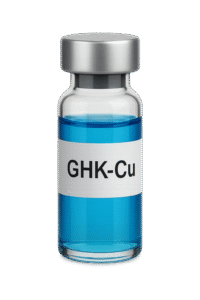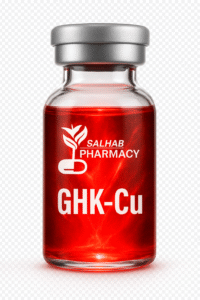
GHK-Cu Benefits on The Brain
1. Introduction
- Neurodegenerative diseases of aging (e.g., Alzheimer’s, Parkinson’s) cause early debilitation and dependency.
Key processes:
- Oxidative stress.
- Metal homeostasis disruption.

- Neuroinflammation.
- Environmental/dietary factors may cause epigenetic damage.
- Antioxidants (vitamin E, melatonin, resveratrol) show mixed clinical results.
- Metal chelators and dietary restrictions investigated but limited.
GHK-Cu is:
- Safe, natural peptide with diverse regenerative actions.
- Shown to regulate a large number of human genes.
Table of Contents
Toggle
2. Copper Binding Properties of GHK
- Discovered in plasma in 1973.
- Levels: ~200 µg/L at age 20–25 → ~80 µg/L by age 60–80.
- High copper affinity → forms stable GHK-Cu.
- Role: delivers nontoxic copper for cellular functions.
Structural studies show:
- Cu(II) binds to histidine, glycine amino group, and peptide bond nitrogen.
- Stable binary/ternary structures possible.
- Can acquire copper from plasma albumin.
- Prevents oxidative damage by silencing redox activity.
3. The Copper Paradox
- Copper is essential but excess free copper may cause oxidative stress.
- Copper deficiency → severe neurological issues in humans and mice.
Alzheimer’s disease (AD):
- Copper role debated (cause vs. consequence).
- Some evidence: copper deficiency may be linked to AD.
Clinical trials:
- 8 mg/day copper supplementation improved AD markers.
- Suggests copper supplementation may be protective.
- GHK: forms nontoxic copper complexes, increases bioavailability.
4. Antioxidant and Anti-Inflammatory Properties
- Brain vulnerable: high oxygen use, rich in unsaturated fatty acids, few antioxidants.
- SOD1 (superoxide dismutase) requires copper/zinc.
- Copper deficiency reduces activity → more oxidative damage.
GHK-Cu:
- Restores SOD activity.
- Inhibits lipid peroxidation (e.g., ferritin-bound iron).
- Quenches toxic lipid peroxidation products (HNE, acrolein).
Anti-inflammatory effects:
- Lowers TNF-alpha and TGF-beta cytokines.
- Improves ischemic wound healing.
5. GHK Stimulates Blood Vessel Growth
- Brain health depends on vascular integrity.
GHK-Cu promotes:
- Angiogenesis.
- Anticoagulation.
- Vasodilation.
- Increases VEGF and bFGF.
- SPARC protein: contains GHK sequence; released during tissue damage.
- Stimulates vessel growth until blood flow restored.
6. GHK Increases Neurotrophins
- Neurotrophic factors reduce oxidative damage and support neurons.
Evidence:
- GHK stimulates nerve outgrowth in culture.
- In collagen implants, increased NGF, NT-3, NT-4.
- Boosted axon count and Schwann cell proliferation.
7. GHK as a Gene Regulator
Epigenetic factors influence neurodegeneration.
GHK-Cu effects:
- Accelerates wound healing.
- Stimulates synthesis and breakdown of collagen/glycosaminoglycans.
- Modulates metalloproteinases (MMPs) and inhibitors (TIMPs).
- Increases mRNA for ECM components (collagen, decorin).
- Upregulates integrins and p63 (epidermal stem cell markers).
Connectivity Map studies:
- 268 genes upregulated, 167 suppressed.
Cancer studies:
- Suppressed RNA in 70% of metastatic colorectal cancer genes.
8. Connectivity Map and GHK Genes
Connectivity Map data:
- 76 genes upregulated, 6 downregulated at 1 μM GHK.
Nervous system genes stimulated:
- SIGMAR1 (dementia-linked).
- EPM2A (Lafora disease).
- NAIP (anti-apoptotic).
- FGFR2 (embryonic brain development).
- SLIT2 (nervous system development).
Demonstrates potential neuroprotective gene regulation.
9. GHK May Reverse Gene Silencing
- Age 20–25: peak health → decline later.
- Epigenetic silencing increases inflammation, cancer risk.
- HDAC enzymes implicated in neurodegeneration.
- GHK: strong HDAC inhibitor.
- Suggests potential in reversing gene silencing → protective effects.
10. Therapeutic Administration of GHK-Cu
- Advantages of GHK-Cu over GHK: prevents copper deficiency, safe delivery.
- Likely able to cross blood-brain barrier.
Delivery methods:
- Intravenous.
- Oral (liposome-encapsulated).
- Effective systemic wound healing at 1.1 mg/kg in pigs (~75 mg in humans).
- Therapeutic window far below toxic dose.
- Effective at nanomolar concentrations.
11. Conclusion
Cognitive decline involves multiple mechanisms: oxidative stress, inflammation, copper imbalance, poor circulation, epigenetics.
GHK-Cu is:
- Natural and safe.
- Antioxidant and anti-inflammatory.
- Supports circulation, stem cells, neurotrophins.
- Regulates genes and reverses harmful epigenetic changes.
- Proposed as a promising neuroprotective agent for age-associated disorders.

